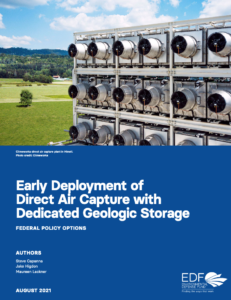Full Title: Early Deployment of Direct Air Capture with Dedicated Geologic Storage: Federal Policy Options
Author(s): Steve Capanna, Jake Higdon, Maureen Lackner
Publisher(s): Environmental Defense Fund (EDF)
Publication Date: August 30, 2021
Full Text: Download Resource
Description (excerpt):
To avoid the worst effects of climate change, the world must not only flatten its current greenhouse gas emissions trajectory, but accelerate toward net-zero emissions by roughly mid-century – and most-likely sustain net-negative emissions in the latter half of the century. In recent years, carbon dioxide removal (CDR) technology has moved from theoretical concept to pilot scale, producing a handful of potentially scalable approaches for generating negative emissions by capturing carbon dioxide (CO2) from the atmosphere. This CO2 can then be permanently sequestered in the geosphere or put to use in such industrial processes as cement production. There are many technology– and nature-based CDR approaches that have the potential to play a meaningful role in achieving our climate goals. This paper explores just one technology-based approach: direct air capture (DAC) with dedicated geologic storage, also known as direct air carbon capture and sequestration (DACCS). DACCS is an expensive and untested technology today, and like other CDR methods, there is no guarantee DACCS will end up being a central part of the climate solution. However, early action to develop, pilot, and deploy DACCS can help us drive down costs and explore its potential.
All of this suggests that public policy will play an essential role in driving efforts to mature DACCS into a viable and cost-effective carbon dioxide removal strategy – not merely to get the technology off the ground, but to be able to operate it at scale by mid-century and beyond. In this paper, we seek to understand which policy tools could most effectively drive early deployment of DACCS, which we define as capturing and storing 2-3 megatonnes of CO2 per year in the U.S. by 2030. While our primary focus has to stay on mitigating existing emissions, beginning to build DACCS plants at commercial scale will help drive price discovery and innovation so that we can determine whether DACCS is capable of growing rapidly in the late 2030s and 2040s.
